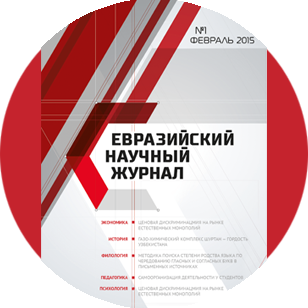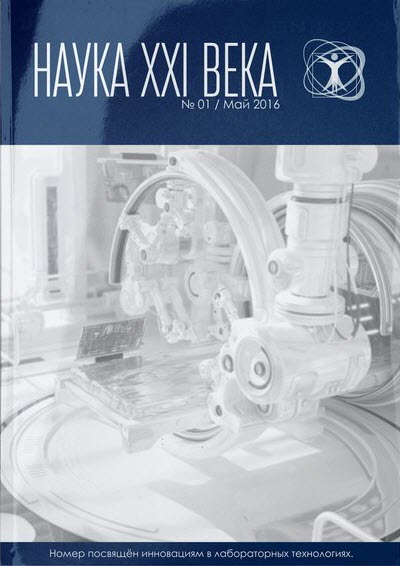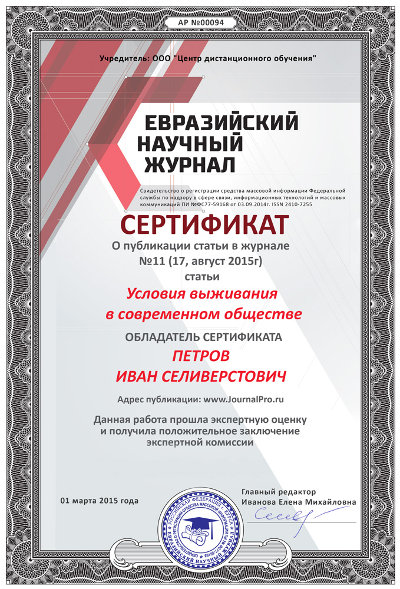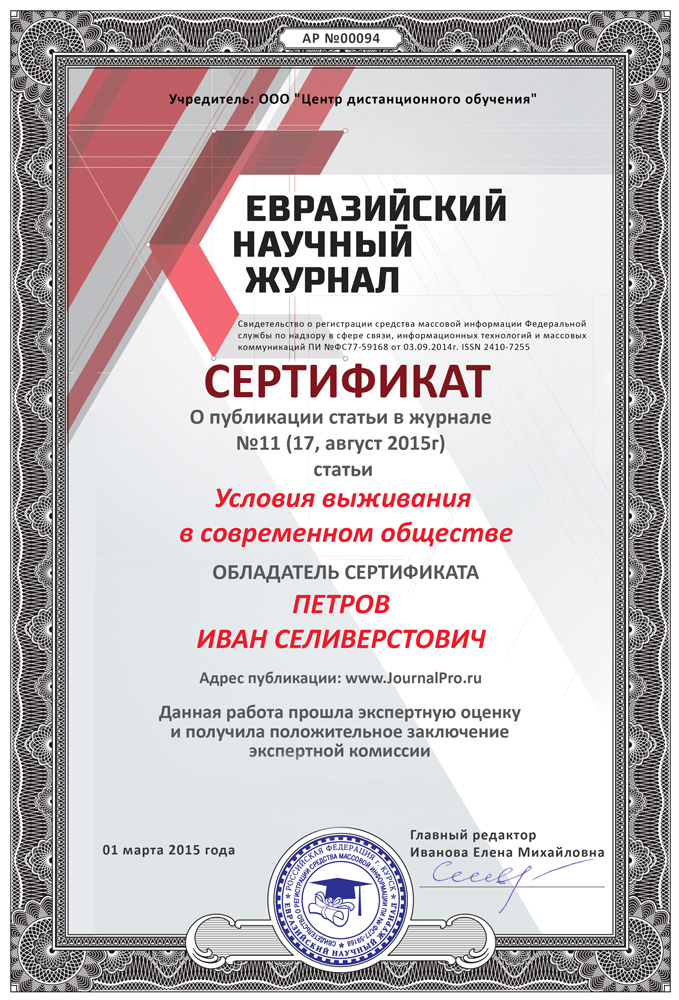Срочная публикация научной статьи
+7 995 770 98 40
+7 995 202 54 42
info@journalpro.ru
TRANSLATION OF REALIAS AS AN OBJECT OF INTERCULTURAL COMMUNICATION
Рубрика: Филологические науки
Журнал: «Евразийский Научный Журнал №6 2021» (июнь, 2021)
Количество просмотров статьи: 1671
Показать PDF версию TRANSLATION OF REALIAS AS AN OBJECT OF INTERCULTURAL COMMUNICATION
Malika Norboyeva,
Master’s degree student
of Samarkand State Institute of Foreing languages
Abstract: This article provides detailed information on realia as an object of translation.
Keywords: reality, translation, target language, source language, language, unfamiliar reality, translator
The oldest and most difficult problem of translation is, of course, in the possibility of adequate transfer of the content of a text from one language to another. When assessing the adequacy of the translation, analysts often allow themselves not to think about whether the conclusions of such an analysis can be recognized as reliable, or about the degree of reliability of the proposed conclusions. The grammatical-translation method of studying foreign languages implicitly inspires us with the idea that in translation, in order for it to become beautiful, everything must be reproduced — words, grammatical constructions, verb tenses, phraseological expressions, and even morphemes. Meanwhile, a careful study of the translated texts shows that the ultimate adequacy, i.e. the adequacy of the translation of the entire text is in excellent agreement with some particular “inaccuracies” in the translation of units of the same text. The very concept of accuracy / inaccuracy of translation in relation to elementary units and to the whole text depends on many factors. One thing is clear: the translator must do everything in his power to “re-express” what the author has expressed.
Translation of realities is part of a large and important problem of transferring national and historical originality, which probably goes back to the very birth of translation theory as an independent discipline. They started talking about realities as indicators of color only in the early 50s. L.N. Sobolev in 1952 uses the term “reality” in its modern sense and even gives it a fairly consistent definition. G.V. also writes about realities. Chernov, who, however, mainly uses the name “non-equivalent vocabulary.” A.E. Suprun considers realities as “exotic” vocabulary, and Vl. Rossels outlines some of the main features of reality as a translation category. Thus, it is safe to say that this problem has been considered to one degree or another by all translation theorists.
The word “realia” itself comes from the Latin plural neuter adjective realis, -e, realia — “real”, “real”, which has become a feminine noun under the influence of similar lexical categories. This word denotes a materially existing or existing object, often linking it in meaning with the concept of “life”; for example, “the realities of European life.” According to the dictionary definitions, reality is “any object of material culture,” “in classical grammar, various factors ... such as the state structure of a given country, the history and culture of a given nation, linguistic contacts of speakers of a given language, etc. from the point of view of their reflection in a given language ”," objects of material culture that serve as the basis for the nominative meaning of the word “. Thus, in translation studies, the term “reality” denotes words that name the above-mentioned objects and concepts.
The concept of “translation of realities” is twice conditional: realia, as a rule, is untranslatable (in dictionary order) and, again, as a rule, it is transmitted (in context) not by translation. A.V. Fedorov wrote that “there is no such word that could not be translated into another language, even descriptively, that is. a common combination of words in a given language”. As a rule, translators are faced with two main difficulties in conveying realities: the lack of an equivalent in the target language due to the lack of a real-life referent for the speakers of this language and the need, along with the subject meaning (semantics) of reality, to convey the color (connotation) historical coloring.
When choosing the most suitable translation technique, it is necessary to pay special attention to the place, presentation and comprehension of the unfamiliar reality in the original. The stranger’s reality is most often unfamiliar. The author introduces it into the text of a work of fiction when describing a reality that is new for a speaker of a given language, for example, in a novel from the life of such and such a people, in such and such a country, narrating about a life that is alien to the reader in this or that episode. These words, unfamiliar to the reader of the original, require a presentation that would allow them to perceive what is being described, while at the same time feeling that specific “aroma of alienation”, a characteristic local or national historical flavor, for the sake of which these foreign elements were included in the text.
Consequently, we can conclude that the most successful one should be considered such an introduction to the text of an unfamiliar reality, which would ensure its completely natural, unconstrained perception by the reader without the use of special means of its comprehension by the author. For the most part, the realities that are familiar to readers do not require explanation either. With even greater reason, regional realities do not require explanation. However, in doubtful situations, the translator must carefully check whether the word in question exists in the target language, whether it corresponds in meaning to the one being translated in the source language and what is its phonetic and graphic appearance in the target language.
Very often, the considerations of the writer and the translator include the expectation of contextual comprehension, the fact that the reader will understand the introduced reality “in meaning”. There are also frequent cases of overestimation of the background knowledge of the reader, when the author does not explain the reality, someone else’s or his own, but clearly unfamiliar to the reading public. This applies to many historical writers. It is obvious that the reader who encounters an unfamiliar reality in the original is in a somewhat more favorable position compared to the reader of the translation. Some writers expect that the reader will inquire about the meaning of an unfamiliar word in dictionaries, however, according to S. Vlakhov and S. Florin, it is unlikely that a reader (not a scientist or researcher) who has taken a book for pleasure will start rummaging through dictionaries. The presentation and interpretation of realities in special dictionaries, commentaries and glossaries at the end of the book, part, chapter significantly complicates the reader, detaching him from the narrative.
As a rule, translation of historical realities is particularly difficult. It should be remembered that historical realities are usually spoken of not as a specific group of vocabulary, but rather taking into account the historical attribution of realities to a particular era, without losing sight of their subject content, which connects them with the corresponding headings of subject classification.
In conclusion, let me quote the well-known translator A.L. Andres: “In the art of translation, as in any other art, there can be no ready-made standards, once and for all definite rules and decisions. There can be no single solution to the question of whether a translator, re-expressing a work that is separated from us by a certain historical distance, should make the modern reader feel this distance and to what extent he should do it”.
The list of used literature:
1. Андрес А.Л. Дистанция времени и перевод. / А.Л. Андрес. — МП: № 5, 1966. — С. 128.
2. Ахманова О.С. Словарь лингвистических терминов. / О.С. Ахманова. — М.: Сов. энциклопедия, 1966. — 524 с.
3. Бреус Е.В. Основы теории и практики перевода с русского языка на английский.
4. Влахов С. Непереводимое в переводе. / С. Влахов, С. Флорин. — М.: “Международные отношения”, 1980. — 343 с.
5. Ожегов С.И. Словарь русского языка. Изд.









